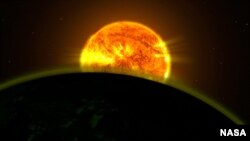Scientists say they have found evidence of water on five planets outside our solar system.
Using the NASA Hubble Space Telescope, astronomers studied what they called “hot Jupiters,” massive worlds that orbit close to their relatively nearby stars. And while they say water has been reported on other exoplanets, this study was the “first study to conclusively measure and compare the profiles and intensities of these signatures on multiple worlds.”
The official names of the planets are WASP-17b, HD209458b, WASP-12b, WASP-19b and XO-1b.
"We're very confident that we see a water signature for multiple planets," said Avi Mandell, a planetary scientist at NASA's Goddard Space Flight Center in Greenbelt, Maryland, and lead author of an Astrophysical Journal paper published earlier this month that describes the findings. "This work really opens the door for comparing how much water is present in atmospheres on different kinds of exoplanets, for example hotter versus cooler ones."
NASA said the strengths of their water signatures varied. WASP-17b, a planet with an especially puffed-up atmosphere, and HD209458b had the strongest signals. The signatures for the other three planets, WASP-12b, WASP-19b and XO-1b, also are consistent with water, the space agency said.
The observations were made in a range of infrared wavelengths where the water signature, if present, would appear. The teams compared the shapes and intensities of the absorption profiles, and the consistency of the signatures gave them confidence they saw water.
"To actually detect the atmosphere of an exoplanet is extraordinarily difficult. But we were able to pull out a very clear signal, and it is water," said L. Drake Deming of the University of Maryland in College Park, Maryland, whose team reported results for HD209458b and XO-1b in a Sept. 10 paper in the same journal. Deming's team employed a new technique with longer exposure times, which increased the sensitivity of their measurements.
"These studies, combined with other Hubble observations, are showing us that there are a surprisingly large number of systems for which the signal of water is either attenuated or completely absent," said Heather Knutson of the California Institute of Technology, a co-author on Deming's paper. "This suggests that cloudy or hazy atmospheres may in fact be rather common for hot Jupiters."
Using the NASA Hubble Space Telescope, astronomers studied what they called “hot Jupiters,” massive worlds that orbit close to their relatively nearby stars. And while they say water has been reported on other exoplanets, this study was the “first study to conclusively measure and compare the profiles and intensities of these signatures on multiple worlds.”
The official names of the planets are WASP-17b, HD209458b, WASP-12b, WASP-19b and XO-1b.
"We're very confident that we see a water signature for multiple planets," said Avi Mandell, a planetary scientist at NASA's Goddard Space Flight Center in Greenbelt, Maryland, and lead author of an Astrophysical Journal paper published earlier this month that describes the findings. "This work really opens the door for comparing how much water is present in atmospheres on different kinds of exoplanets, for example hotter versus cooler ones."
NASA said the strengths of their water signatures varied. WASP-17b, a planet with an especially puffed-up atmosphere, and HD209458b had the strongest signals. The signatures for the other three planets, WASP-12b, WASP-19b and XO-1b, also are consistent with water, the space agency said.
The observations were made in a range of infrared wavelengths where the water signature, if present, would appear. The teams compared the shapes and intensities of the absorption profiles, and the consistency of the signatures gave them confidence they saw water.
"To actually detect the atmosphere of an exoplanet is extraordinarily difficult. But we were able to pull out a very clear signal, and it is water," said L. Drake Deming of the University of Maryland in College Park, Maryland, whose team reported results for HD209458b and XO-1b in a Sept. 10 paper in the same journal. Deming's team employed a new technique with longer exposure times, which increased the sensitivity of their measurements.
"These studies, combined with other Hubble observations, are showing us that there are a surprisingly large number of systems for which the signal of water is either attenuated or completely absent," said Heather Knutson of the California Institute of Technology, a co-author on Deming's paper. "This suggests that cloudy or hazy atmospheres may in fact be rather common for hot Jupiters."









